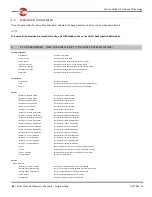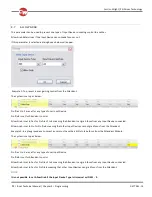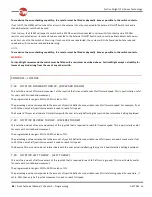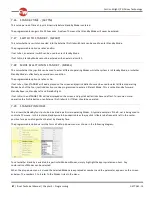
Curtiss-Wright | PG Drives Technology
SK77981-14
72 | R-net Technical Manual | Chapter 3 – Programming
It is not possible to set Allow Grab to No on more than one Input Device Type.
CONFIGURATION EXPLA INED
The R-net system supports 8 Modes of operation. A Mode is the output action that the system is undertaking, for example,
driving, seat adjustment or Mouse control. In other words, each Mode requires a piece of output hardware. For Drive it would
be the Power Module, for Seat adjustment it would be the Seating Module and for Mouse control it would be a Bluetooth
Mouse Module. Note, On-board Programming (OBP) will take over a Mode and by convention this will be Mode 8.
The system can be programmed to set which output function is active for each mode. In general, Mode 1 will always be Drive,
Mode 2 will always be Seating Control and Mode 8 will always be OBP. However, it may be desirable to change the output
assignation of some of the more specialist Modes. This can achieved with the parameter, Output. See below for more details.
A Mode will only be available if the output hardware is actually connected in the system. The parameter, Output, is therefore
essential in ensuring the full “Plug & Play” capabilities of R-net are utilized.
Example: A wheelchair model is launched with Drive and Seating functions, but it is intended to allow optional features such as
environmental control or PC mouse control to be fitted in the field. To ensure this means no more than simply connecting
appropriate pieces of hardware, then the system should be programmed as below.
This means that when the wheelchair is initially shipped, with a Power Module and Seating Module fitted, then Modes 1 and 2
will be Drive and Seating Control respectively and tha t Mode 8 would be used for OBP.
If, at some point in the future an Environmental Control Module is required, then Mode 4 would automatically become
available to the user. I.e. the Mode button would step through Drive, Seating and Environmental Modes. The other Modes - PC
Mouse, Output 5, Output 6 and Output 7 - would also become available if relevant modules were connected.
Within each Mode it is necessary to ensure the appropriate data is transmitted from the Input Device to the Output Device. A
good example of this is the Speed Up and Speed Down button. In Drive Mode they change the speed setting in the Joystick
Module and it is that setting, rather than the actual state of the buttons, that is transmitted to the Power Module. However, in
Mouse Mode it is desirable for the state of the Speed Up and Speed Down buttons to be transmitted on the Output Device. This
means the buttons can be used to control other functions, such as mouse left/right clicks. The parameter, Input, sets the dat a
for each mode. See section, Input, for more details.
: USER DISPLAYS :
There is some flexibility as to what is displayed to the user to indicate the operating Mode of the system. The Drive, Seatin g and
OBP modes are indicated by the standard screens and cannot be changed. However, the Mouse Mode displays an image of a PC
with an associated text string, whereas the other Modes simply have an associated text string. An example of a Mode screen is
shown below. The text string is programmable via the pa rameter, Mode Name.
Bluetooth Mode
Содержание R-NET
Страница 1: ...PG DRIVES TECHNOLOGY R NET TECHNICAL MANUAL SK77981 14 ...
Страница 46: ...Curtiss Wright PG Drives Technology SK77981 14 46 R net Technical Manual Chapter 2 Installation 6 1 3 CRIMPING ...
Страница 58: ...Curtiss Wright PG Drives Technology SK77981 14 58 R net Technical Manual Chapter 2 Installation ...
Страница 174: ...Curtiss Wright PG Drives Technology SK77981 14 174 R net Technical Manual Chapter 8 ISM 8 ...
Страница 194: ...SK77981 14 194 R net Technical Manual Chapter 10 Diagnostics Curtiss Wright PG Drives Technology ...
Страница 206: ...SK77981 14 206 R net Technical Manual Chapter 12 Specifications Curtiss Wright PG Drives Technology ...









































